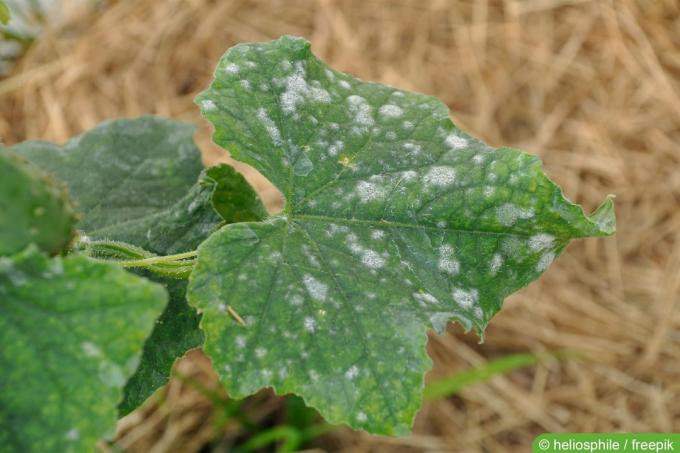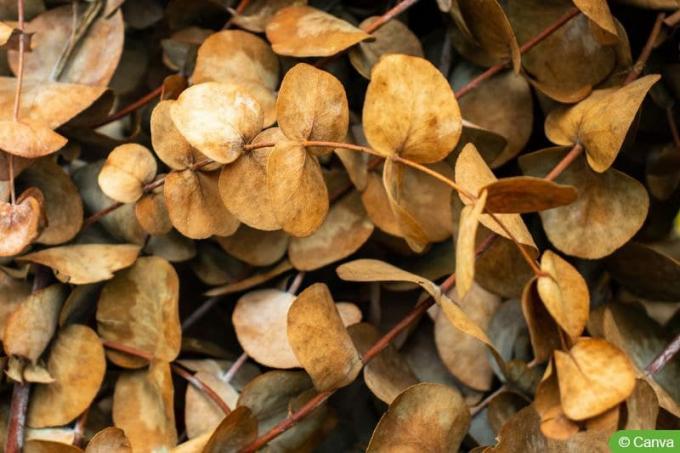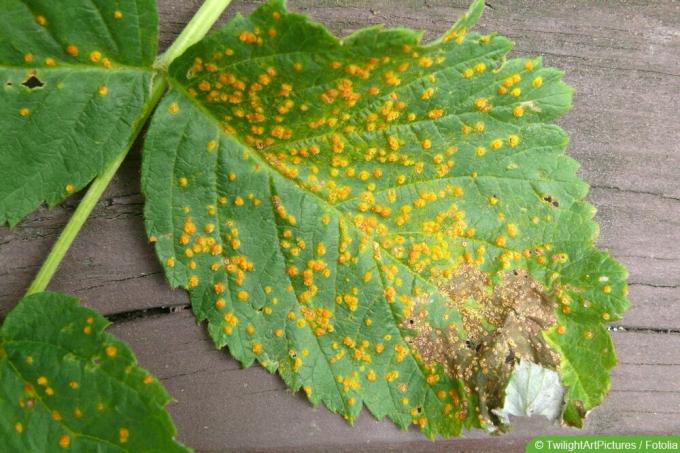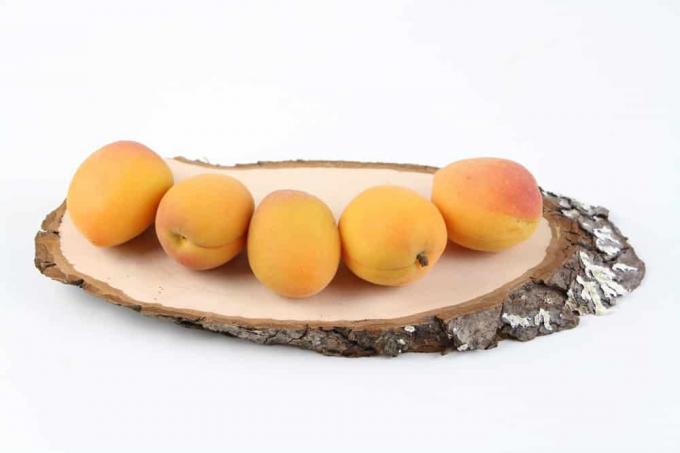

Table of contents
- Check cucumber plants regularly
- Powdery mildew (Erysiphaceae)
- Downy mildew (Peronosporaceae)
- Act early, discard late
- Remove badly affected leaves
- Injections with natural agents
- baking powder
- nettle manure
- garlic tea
- milk
- Sakhalin knotweed infusion
- saline solution
- Chemicals
- Prevent cucumber powdery mildew
- Grow resistant cucumber varieties
Both powdery mildew and downy mildew can bring the cucumber harvest to an abrupt end. The fact that they attack the popular plant can never be completely avoided. It is all the more important to effectively destroy the fungal pathogens. With our instructions, you can do this in an environmentally friendly way.
Check cucumber plants regularly
For successful control, it is crucial that you discover powdery mildew as early as possible. Both plants outside in the bed and in the greenhouse are affected. Check your cucumber plants regularly for symptoms of these fungal diseases. Both species can be easily recognized and distinguished from each other, although the distinction is not decisive for control. Below is an overview of the typical symptoms:
Powdery mildew (Erysiphaceae)
- Powdery mildew loves hot and dry summer weather
- is also known as the fair-weather mushroom
- a mealy-white fungus lawn can be seen on the upper side of the leaves
- the spots are small at first, but quickly become larger
- Leaves turn brown and dry up
- the whole plant dies
Tip:
Powdery mildew is non-toxic to humans and rarely triggers allergic reactions. Since it only affects the leaves of the cucumber plant anyway, you can eat the fruit without hesitation.
Downy mildew (Peronosporaceae)
- Downy mildew loves moisture and rain
- as well as cooler temperatures (10-18 °C)
- The undersides of the leaves first show watery, angular spots
- they are increasingly covered with a gray to violet mushroom lawn
- Cucumber leaves turn yellow within a few days
- they die off, starting from the edge of the leaf
- the whole plant dies
Act early, discard late
If a cucumber plant is badly affected, you should not waste time with useless measures. Instead, remove them completely from the bed or greenhouse so that the fungal pathogens do not spread to other cucumber plants or overwinter in the ground. Otherwise, you should start fighting immediately, because the fungal pathogens spread quickly.

Tip: Plants affected by powdery mildew do not belong in the compost. The pathogens would survive in it and return to the beds together with the mature compost. Put all plant parts in the residual waste bin or the municipal organic waste bin.
Remove badly affected leaves
Sometimes not the entire plant is covered with a fungus lawn, but some leaves or tendrils are strong. You should cut away and dispose of these and only then take further control measures. Clean the scissors before and after cutting to avoid spreading to other plants.
Injections with natural agents
Natural pesticides help against both types of mildew and are environmentally friendly. They can therefore be used several times without hesitation, so that the powdery mildew is really completely defeated. In addition, they are readily available and almost free. Spray the cucumbers preferably in the evening, never in the blazing sun. Do not leave out any parts of the plant.
baking powder
The baking powder is the main ingredient, but there are other ingredients as well. Adjust the recipe below to get the amount you need:
- 100 grams of baking powder
- 100 ml rapeseed oil
- 1 tbsp washing-up liquid
- 10 liters of lukewarm water
nettle manure
Nettle manure is routinely produced every year in many home gardens. Diluted 1:10 it can also be used as a spray against powdery mildew. If you don't have ready-made nettle manure at hand, use another method to avoid wasting time.

Tip:
Nettle manure can be used in many ways in the garden. As a fertilizer and to combat fungal diseases and pests. Since the finished liquid manure can be stored for a whole year, it is always worth making some in stock.
garlic tea
Cut four cloves of garlic into small pieces and pour 1 liter of boiling water over them. After the brew has completely cooled, it is filtered and is immediately ready for use.
milk
Mix skimmed milk with rainwater in a ratio of 1:6. Sprinkle all the cucumber leaves with it. This solution, which is considered the most effective against powdery mildew, is also suitable for watering the plants.
Sakhalin knotweed infusion
The Sakhalin knotweed, scientifically Reynoutria sachalinensis, is considered a problematic neophyte, so it should not be specifically settled. However, if you have access to a plant, it can be useful against cucumber powdery mildew. For this purpose, 10 g of dried leaves are poured over with 1 l of hot water, filtered after several hours and sprayed onto infested cucumber plants.
saline solution
If the fight has to be quick, you can also use salt, which is available in every household. Dissolve half a teaspoon of it in a liter of water and spray the cucumber plants with it. However, do not repeat this spraying as often as the salt will get into the soil.
Chemicals
Several chemical agents against powdery mildew are waiting on the store shelves. Since their use is questionable, check carefully whether and which one you want to use, especially since the household remedies described above are good for mildew. If it has to be a fungicide, choose the least evil that is effective in small quantities and spares the pollinating insects. If necessary, ask the specialist store what the current supply situation is.
Prevent cucumber powdery mildew
- Observe crop rotation of four years
- Use plant strengtheners
- Plant basil, chervil or chives between cucumbers
- Consistently remove weeds from the bed (carrier)
- Ventilate the greenhouse in the mornings and evenings
Grow resistant cucumber varieties
Growers know the problem with cucumber powdery mildew. They have therefore developed many varieties that are tolerant or resistant to powdery mildew and downy mildew. Here are a few F1 hybrids:
pickled cucumbers:
- capra
- Excelsior
- dragon-fly
- Othello
- restina
- Schubert
- zircon
cucumbers:
- Burpless Tasty Green
- Dominica
- Euphya
- jazzer
- solvent earth
- Styx (hothouse cucumber)
- Sudica
mini cucumbers:
- passandra
- Printro
 Home editorial office
Home editorial office
Learn more about plant diseases

Eucalyptus gets brown/yellow leaves
The eucalyptus is becoming more and more of a trend plant. With its blue-green leaves, the eucalyptus sets beautiful accents. Occasionally, however, foliage discoloration may occur. Everything about the causes and remedial measures below.

Small white dots on leaves: what to do?
When white dots appear on the leaves of crops, take a closer look as they can indicate problems. This text explains what causes can be responsible for this and what you can do about the stains.

Fighting frizz | 9 home remedies
Peaches from your own garden taste wonderful. More and more hobby gardeners are trying to grow the tasty fruits themselves. The joy is clouded by the appearance of leaf curl in spring. What is this disease? How can you prevent or fight them?

Fighting rust on plants biologically | 5 home remedies
Leaf or plant rust is caused by fungi and can affect ornamental plants as well as crops. Most species of fungi are specialized to a single host or host family and are transmitted by wind. The infestation rate increases significantly with moisture.

10 typical diseases of the apricot tree and apricot tree
Apricots are one of the most popular fruits in Germany. It becomes difficult to care for an apricot tree in such a way that it is not attacked by a disease. Apricots are known for their susceptibility to diseases and it is therefore important to be able to distinguish between the individual diseases.

Fight wine diseases | 10 typical diseases of grapevines
Vine diseases can not only reduce the yield of the plants or even completely eliminate them - they can also kill entire plants and spread in the garden. They should therefore always be taken seriously and treated quickly. We reveal what is important.
